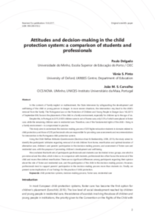Abstract
In the contexts of family neglect or maltreatment, the State intervenes by safeguarding the development and well-being of the child or young person in danger. In more severe situations, the intervention may lead to the child’s removal from the family. The Portuguese Law on the Protection of Children and Young People in Danger (Law 142/2015 of September 8th) favours the placement of the child in a family environment, especially for children up to the age of six.
Despite this, in Portugal, in 2015, 8 600 children were in out-of-home care, only 3.5% of which were placed in foster care, while the remaining children were in residential care. Therefore, one of the fundamental rights of the child – living in a family environment – is compromised in practice.
This study aims to understand the decision-making process of 200 higher education students in domains related to child protection, and those of 200 professionals who are responsible for providing case assessments and recommendations for intervention in the Portuguese child protection system.
Using the Child Welfare Attitudes Questionnaire (Davidson-Arad & Benbenishty, 2008, 2010), the study aimed to identify the participants’ attitudes regarding removal of at-risk children from home, reunification and optimal duration of alternative care, children’s and parents’ participation in the decision-making process, and assessment of foster care and residential care, with the purpose of promoting children’s development and well-being.
We concluded that both sets of participants (professionals and students) can be divided in two groups, one which is pro-removal and the other, which is less so. In comparison with students, professionals less often favour the removal of the child and more often defend reunification. There are no significant differences among participants regarding their opinion about the role of foster and residential care, and the participation of the child in the decision-making process. However, professionals tend to support parents’ participation in the decision-making process more than students do. Finally, we present some implications of our findings for the practice of child protection.

